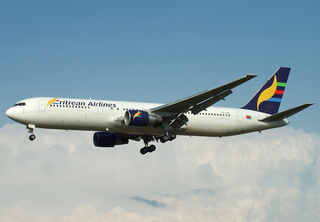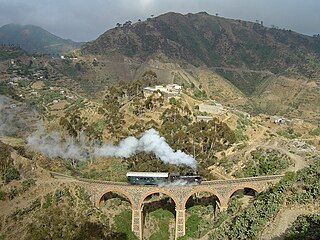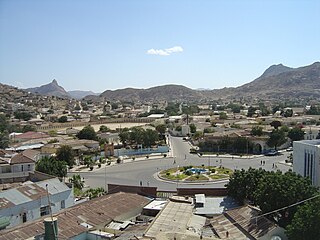Serejeqa (Arabic : سيريجاكا, Tigrinya : ሰረጃቓ) is a town in the Anseba Region of Eritrea. It is located about 20 km northwest of Asmara on the asphalt road to Keren, which in turn lies roughly 75 km away. The town is situated on the ridge of the Eritrean highlands. It is the upper endpoint of a gravel-road that traverses the eastern escarpments and has its other endpoint in Shebah, on the low-lying plains at the foot of escarpments. With this gravel road, Serejeqa connects the north-western part of the highlands, including the city of Keren (Eritrea's third largest city) with the Red Sea and the port of Massawa (the second largest city). This route can be traveled without having to pass through the congested capital and largest city Asmara or use the equally congested mountain-segment of the Asmara-Massawa asphalt road. Instead, the gravel road beginning in Serejeqa on one end, connects to the She'eb-Gahtelai asphalt road, which in turn unites with the less congested lowland part of the Massawa asphalt road, just 35 km from Massawa itself. Due to its proximity and connections to Asmara, Serejeqa also functions as a suburb of the capital, although it is not part of the metropolitan region of the capital (i.e. Maekel or Central Region).
Tigrinya, often written as Tigrigna is an Afro-Asiatic language, belonging to the family's Semitic branch. It is spoken by ethnic Tigray-Tigrinya in the Horn of Africa. Tigrinya speakers primarily inhabit the Tigray Region in northern Ethiopia (96%), where its speakers are called Tigrawot, as well as the contiguous borders of southern and central Eritrea (57%), where speakers are known as the Tigrinya. Tigrinya is also spoken by groups of emigrants from these regions, including some Beta Israel.

Anseba Region is one of the six administrative regions, located in northern Eritrea. The capital and the most populous city in the region is Keren. The region is named after Anseba River, which passed through most parts of the region. The average elevation in the region is around 1,800 m (5,900 ft) to 2,100 m (6,900 ft). The hottest month is May recording temperatures up to 30 °C (86 °F), while the coldest month is December to February when it reaches freezing temperature. The region received around 508 mm (20.0 in) of rainfall and the soil is conducive for agriculture.

Eritrea, officially the State of Eritrea is a country in the Horn of Africa, with its capital at Asmara. It is bordered by Sudan in the west, Ethiopia in the south, and Djibouti in the southeast. The northeastern and eastern parts of Eritrea have an extensive coastline along the Red Sea. The nation has a total area of approximately 117,600 km2 (45,406 sq mi), and includes the Dahlak Archipelago and several of the Hanish Islands. Its toponym Eritrea is based on the Greek name for the Red Sea, which was first adopted for Italian Eritrea in 1890.









